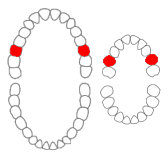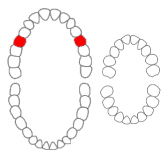We just learned about the Maxillary Second Molar.
The next tooth back in the mouth is the Wisdom Toothor Third Molar.
This tooth is a molar just like the first and second molars.
Many times there is not enough room in a person's mouth for these teeth, so a dentist or orthodontist will pull the teeth out.
If these teeth stay in the mouth, they can push up against the other teeth and hurt them.
Sometimes the gums in the mouth can get swollen or bruised by these teeth.


(from: wikipedia - wisdom tooth)
Kid Facts - Blast from the past: Lunula













